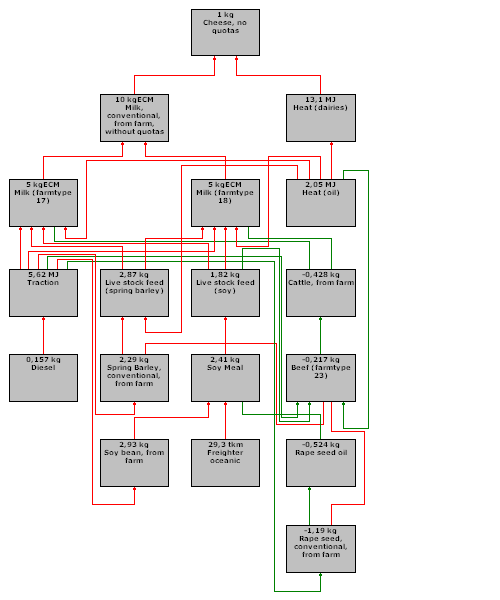Yellow cheese (without quotas)
Yellow cheese is produced from milk produced at dairy farms. The marginal farms cannot be determined based on experience because the market has been regulated by quotas for many years (Andersen and Jensen, 2003). However, based on (Andersen and Jensen, 2003) it has been assumed that the marginal milk is produced at sandy soils at farms with high livestock density (Farm type 17 (50%) and 18 (50%)). Furthermore, it has been assumed that Danish milk production is determining the extent of cattle production and that milk fat is still in excess in the market and that cream is still converted into butter and exported and sold cheap (see cattle and butter).
The main processes influenced by yellow cheese demand ex dairy are shown in the figure below.
|
|
| Figure 1: Market based product chain diagram for yellow cheese production covering the most important processes in terms of contribution to global warming in an envisioned scenario without milk quotas. Boxes refer to production processes. Names of grey boxes refer to the main product of the processes. Red arrows represent material or energy transfer between two processes; green arrows represent saved material or energy transfer as a result of displacements; green lines represent displacements and red lines represent avoided displacements. Further details can be found in the LCA model. |
Milk is produced by dairy cows at farm type
17 and 18. The milk is processed
into cheese, whey and cream. Whey is converted into whey powder which
is used for animal feed and cream is converted into butter. It has been
assumed (Landbrugets
rådgivningscenter, 2000)
that whey powder displaces spring barley and soy meal in animal feed and
that cream is processed into butter and exported to Russia and sold cheap
without displacing anything (see butter). The
avoided impacts associated with displacement are too limited to be seen
in the above the diagram. For details about processes prior to the dairy,
see milk ex farm.
The table below show the potential environmental impacts associated with yellow cheese demand ex dairy and ex retail. All data are provided per kg of yellow cheese.
| Impact category | Unit | Ex dairy |
Ex retail |
||
|
Conventional |
Organic |
Conventional |
Organic |
||
|
Global warming |
g CO2-eq. | 11200 |
|
11300 | |
|
Acidification |
g SO2-eq. | 101 |
|
101 | |
| Nutrient enrichment | g NO3-eq. | 467 | 467 | ||
| Photochemical smog | g ethene eq. | 3.2 | 3.3 | ||
| Land use | m2 year | 13 | 13 | ||
| Location in database: Materials/scenario without milk quotas/food from industry/ and Materials/scenario without milk quotas/food from supermarket |
 Node
cut-off: 9.0%
Node
cut-off: 9.0%